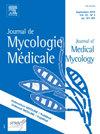Phaeohyphomycosis caused by Exophiala oligosperma in liver transplant recipient: case report and literature review
IF 1.8
4区 医学
Q3 MYCOLOGY
引用次数: 0
Abstract
Phaeohyphomycosis (PHM) is a fungal infection caused by a group of dematiaceous (darkly pigmented) fungi. In this study, we describe a successfully treated case of PHM caused by Exophiala oligosperma in a 68-year-old liver transplant recipient who presented with painful erythematous subcutaneous nodules on his lower left limb. Treatment involved a combination of antifungal drugs and surgical excision. We performed review of 13 cases of PHM in liver transplant recipients reported from 2000 to 2024. Eight patients presented with skin and subcutaneous tissue involvement and limbs were the most frequently affected areas. The median time after liver transplant to the diagnosis of PHM was 6 months. Laboratory diagnosis mainly relied on histopathology. Eleven patients received systemic antifungal therapy and seven underwent surgical excision. Full recovery was observed in eleven cases. Altogether, PHM in solid organ transplant recipients is a rare infection and early diagnosis is critical for a favorable outcome.
肝移植受者少精子外生褐丝酵菌病1例报告并文献复习
褐丝酵母菌病(PHM)是一种真菌感染引起的一组暗色(深色)真菌。在这项研究中,我们描述了一个成功治疗的PHM由少精子外缘引起的68岁肝移植患者,他的左下肢出现了疼痛的红斑性皮下结节。治疗包括抗真菌药物和手术切除的组合。我们对2000年至2024年报告的13例肝移植受者PHM进行了回顾。8例患者表现为皮肤和皮下组织受累,肢体是最常见的受累部位。肝移植后至PHM诊断的中位时间为6个月。实验室诊断主要依靠组织病理学。11例患者接受了全身抗真菌治疗,7例患者接受了手术切除。11例患者完全康复。总之,实体器官移植受者的PHM是一种罕见的感染,早期诊断对于良好的结果至关重要。
本文章由计算机程序翻译,如有差异,请以英文原文为准。
求助全文
约1分钟内获得全文
求助全文
来源期刊
CiteScore
5.10
自引率
2.80%
发文量
68
审稿时长
6-12 weeks
期刊介绍:
The Journal de Mycologie Medicale / Journal of Medical Mycology (JMM) publishes in English works dealing with human and animal mycology. The subjects treated are focused in particular on clinical, diagnostic, epidemiological, immunological, medical, pathological, preventive or therapeutic aspects of mycoses. Also covered are basic aspects linked primarily with morphology (electronic and photonic microscopy), physiology, biochemistry, cellular and molecular biology, immunochemistry, genetics, taxonomy or phylogeny of pathogenic or opportunistic fungi and actinomycetes in humans or animals. Studies of natural products showing inhibitory activity against pathogenic fungi cannot be considered without chemical characterization and identification of the compounds responsible for the inhibitory activity.
JMM publishes (guest) editorials, original articles, reviews (and minireviews), case reports, technical notes, letters to the editor and information. Only clinical cases with real originality (new species, new clinical present action, new geographical localization, etc.), and fully documented (identification methods, results, etc.), will be considered.
Under no circumstances does the journal guarantee publication before the editorial board makes its final decision.
The journal is indexed in the main international databases and is accessible worldwide through the ScienceDirect and ClinicalKey platforms.

 求助内容:
求助内容: 应助结果提醒方式:
应助结果提醒方式:


